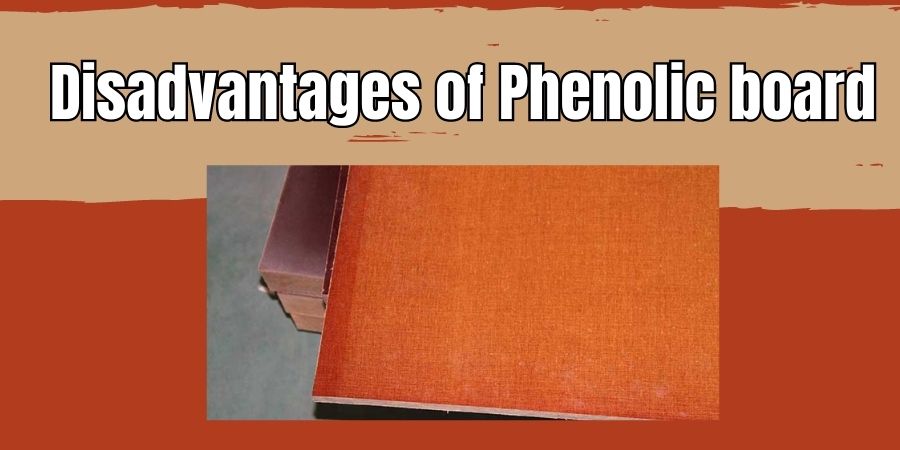Compared to other types of engineered wood boards, such as plywood or medium-density fiberboard (MDF), phenolic board is typically denser and more moisture-resistant. It is also known for its high strength-to-weight ratio and resistance to fire, chemicals, and UV radiation.
Phenolic board is made through a process called impregnation, where the kraft paper or other fibers are soaked in a liquid phenolic resin. The resin then cures and hardens under heat and pressure, forming a solid, dense board. The resulting board can be cut, drilled, and shaped to meet specific project requirements.
Table of Contents
Disadvantages of Phenolic board

Heavy weight
Phenolic board is a dense and heavy material, which can make it difficult to work with, transport, and install. It may also require more support or reinforcement than other materials, which can add to the overall cost of a project.
Limited color options
As I mentioned earlier, phenolic board typically has a black or dark brown color. While some manufacturers may offer variations of these colors, the overall range of color options is still limited. This can be a drawback for those who want more flexibility in their design choices.
Susceptible to water damage
While phenolic board is moisture-resistant to some extent, it is still susceptible to water damage if it is exposed to prolonged or excessive moisture. This can lead to warping, swelling, or even mold growth, which can compromise the structural integrity of the material.
Not as durable as other materials
While phenolic board is strong and tough, it may not be as durable as other materials in certain applications. For example, it may be more prone to scratches or wear and tear over time. This can be a concern for those who want their projects to last as long as possible.
Limited insulation properties
Finally, phenolic board may not be the best material for insulation purposes. While it does offer some degree of insulation, it may not be as effective as other materials such as fiberglass or foam. This can be a drawback for those who are looking to improve the energy efficiency of their homes or buildings.
Cost
One of the main disadvantages of phenolic board is its cost. Compared to other materials such as plywood or MDF, phenolic board can be relatively expensive. This can make it difficult for DIYers or those on a tight budget to justify using it in their projects.
Limited availability
Another downside of phenolic board is that it may not be readily available at all home improvement stores. This can make it difficult for those who live in rural areas or who don’t have access to specialty stores to obtain phenolic board when they need it.
Difficult to work with
Phenolic board is known for being difficult to work with. It’s tough and hard, which can make it hard to cut, drill, or shape. It also has a tendency to splinter or chip, which can be frustrating for woodworkers.
Not as aesthetically pleasing
Phenolic board has a distinct appearance that may not be as aesthetically pleasing as other materials. It has a black or dark brown color and a smooth, shiny surface. This can make it difficult to match with other materials or finishes.
Environmental concerns
Finally, phenolic board may not be the most environmentally friendly material. It is typically made from a combination of wood fibers and synthetic resins, which may contain harmful chemicals.
Additionally, phenolic board may not be recyclable or biodegradable, which can be a concern for those who are conscious of their environmental impact.
When it comes to choosing a board for your construction or woodworking project, there are many options available. Here’s a brief comparison of phenolic board with some of the other popular types of boards:
Phenolic board vs other boards
phenolic board vs plywood
Plywood is a versatile and affordable option for many projects. It is made by gluing together thin layers of wood veneer, which gives it strength and durability.
Compared to phenolic board, plywood is typically lighter and easier to work with. However, it may not be as moisture-resistant or long-lasting as phenolic board.
phenolic board vs MDF (medium-density fiberboard)
MDF is another popular choice for woodworking projects. It is made by compressing wood fibers and resin into a dense, uniform board.
Compared to phenolic board, MDF is typically less expensive and easier to work with. However, it may not be as strong or durable as phenolic board, and it is more susceptible to moisture damage.
phenolic board vs OSB (oriented strand board)
phenolic board vs OSB is a type of engineered wood board that is made by compressing wood strands and adhesives into a solid panel. It is often used in construction applications, such as roofing or wall sheathing.
Compared to phenolic board, OSB is typically less expensive and more widely available. However, it may not be as moisture-resistant or long-lasting as phenolic board, and it may not have the same level of strength or stability.




